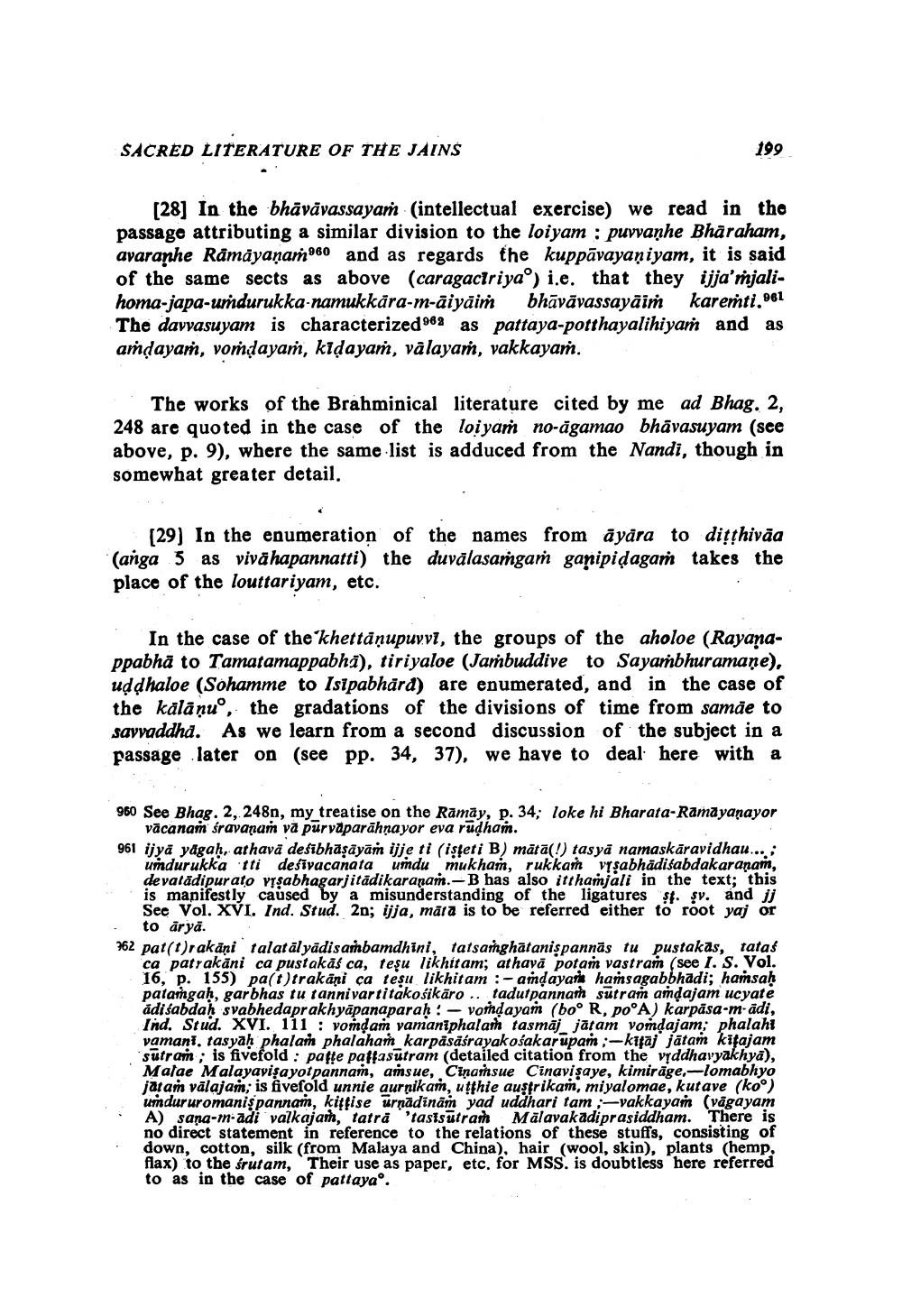________________
SACRED LITERATURE OF THE JAINS
199
[28] In the bhāvāvassayar (intellectual exercise) we read in the passage attributing a similar division to the loiyam : puvvanhe Bhāraham, avaranhe Råmāyaṇam960 and as regards the kuppāvayaniyam, it is said of the same sects as above (caragaciriyao) i.e. that they ijja'mjalihoma-japa-urdurukka-namukkara-m-āiyaiṁ bhāvāvassayāim kareṁti.961 The davvasuyam is characterized 988 as pattaya-potthayalihiyam and as amdayam, vodayam, kidayaṁ, valayam, vakkayaṁ.
The works of the Brahminical literature cited by me ad Bhag. 2, 248 are quoted in the case of the loiyaṁ no-ägamao bhāvasuyam (sce above, p. 9), where the same list is adduced from the Nandi, though in somewhat greater detail.
(29) In the enumeration of the names from ayåra to dithivaa (anga 5 as vivāhapannatti) the duvālasargaṁ ganipidagar takes the place of the louttariyam, etc.
In the case of the khettäņupuvvi, the groups of the aholoe (Rayanappabhā to Tamatamappabhā), tiriyaloe (Jaṁbuddive to Sayambhuramane). uddhaloe (Sohamme to Isipabhard) are enumerated, and in the case of the kalanuo, the gradations of the divisions of time from samäe to savvaddha. As we learn from a second discussion of the subject in a passage later on (see pp. 34, 37), we have to deal here with a
960 See Bhag. 2, 248n, my treatise on the Rāmāy, p. 34; loke hi Bharata-Ramāyanayor
vācanań śravanan vā purvāparāhnayor eva rudha. 961 ijya yagah, athava desībhaşayan ijje ti (isfeti B) māta(!) tasyā namaskāravidhau...;
undurukka iti desivacanata uñdu mukhan, rukkam visabhädisabdakaranam, devatādipur ato vrşabhagarjitādikaranam.-B has also itthanjali in the text; this is manifestly caused by a misunderstanding of the ligatures st. sv. and ij See Vol. XVI. Ind. Stud. 2n; ijja, mäta is to be referred either to root yaj or
to arya. 362 pat(t)rakāni talat al yādi sambamdhini, tatsanghatanispannās tu pustakas, tatas
ca patrakani ca pustakās ca, teşu likhitam; athavă potan vastram (see I. S. Vol. 16, p. 155) pa(t)trakāni ça teşu likhitam : -andayarin hamsagabbhadi; hansah patangah, garbhas tu tanni vartitakośikāro .. tadut pannath sutrañ andajam ucyate ådisabdah svabhedaprakhyāpanaparah! - vodayam (boo R, pooA) karpåsa-m-adi, Ind. Stud. XVI. 111 : vodam vamianiphalath tasmāj jātam voïdajam; phalahi vamani, tasyah phala phalahan karpasāśrayak ośakar upañ,-kitaj jātam kitajam sutram; is fivefold : patte paffasutram (detailed citation from the vyddhavyakhya), Malae Malayavişayot pannan, añsue, Cinańsue Cinavi şaye, kimiräge,-lomabhyo jatam vālajan, is fivefold unnie aurnikań, utthie austrikam, miyalomae, kutave (koo) urdururomanis pannam, kittise urņādinām yad uddhari tam ;-yakkayan (vägayam A) sana-m-adi valkajam, taträ 'tasisutranh Mälavakadi prasiddham. There is no direct statement in reference to the relations of these stuffs, consisting of down, cotton, silk (from Malaya and China), hair (wool, skin), plants (hemp, flax) to the śrutam, Their use as paper, etc. for MSS. is doubtless here referred to as in the case of pattayao.




